Yet again, two policy makers in the Netherlands seized the opportunity to show how much they care about people’s well-being, the environment and cycling. On Friday 7 November last, the alderman for Public Space and Green Space of the city of Utrecht and the representative of the Province of Utrecht with the portfolio of Recreation, officially opened “Cycle viaduct De Gagel” over the Northern Ring road of Utrecht (NRU). The opening of any cycle bridge in the Netherlands is always a perfect opportunity for politicians to make headlines in a positive way, but it is deserved. Thanks to this political decision there now is a good entrance to a nature reserve that has been developed in the last 30 years and that is now nearing its completion. People living in the borough Overvecht can now easily reach that Noorderpark. This viaduct is the only possibility to pass the barrier of the NRU, that previously couldn’t be crossed (legally and safely) for a length of well over 1 kilometre.
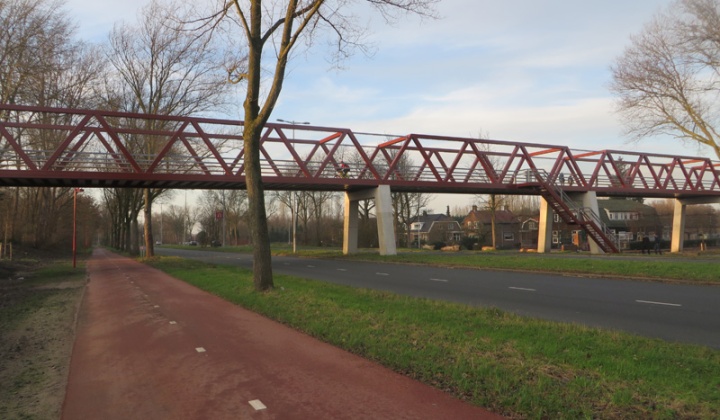
It has been over 2 months since I showed you the last new bridge on my blog. I sometimes get criticised for showing big bridges. It would be “easy blogging” and these bridges wouldn’t be what is important about cycling in the Netherlands. But I think they are an important sign of how much cycling in the Netherlands matters. That the Dutch are building bridges makes very clear that cycling is being taken seriously as a valuable transport option. On this blog I show you very important updates of ‘ordinary’ infrastructure, as well as explanations of standard design features that are virtually unknown in other countries. I also show you how people ride, whether it is in the sun, the rain or in snow. But these big bridges are very important too, because they literally bridge gaps in the cycle grid. More bridges means fewer barriers and that is a good thing.

That is also exactly the motivation for the Utrecht council to build this bridge. To the council it is very important that the green areas just outside the city are easily reached by bicycle. The development of this cycle bridge fits the policies. I showed you before how extra cycle signage to these areas was placed. The cycle viaduct has cost about 2 million euros. The city paid three-quarters, the province the remaining half a million euros.
My video about the Cycle Viaduct De Gagel in Utrecht Overvecht.
The design was inspired by the Bailey Bridge. Which is an originally British type of portable, pre-fabricated, truss bridge that became well-known in the Netherlands as temporary bridge, after many bridges in the country were destroyed in World War II. This area north of Utrecht had a role in the defence system of The Netherlands; The New Dutch Waterline, in which inundated land combined with large bodies of natural water would effectively turn the provinces Holland and Utrecht into an island. That is why this design of a military origin was thought rather fitting for this location.

The measurements of the bridge are as follows:
- Length about 105 metres with 5 bridge parts
- There are 4 spans of 20 metres and 1 span of 25 metres.
- The width is 5 metres and the height of the bridge parts is 4 metres.
The truss bridge parts were constructed in a factory in Heerle (near Bergen op Zoom), about 110 kilometres to the south-west of the location of the viaduct. The parts were completely constructed in the factory, including the final surface and railings. To minimize the nuisance for traffic on the ring road of Utrecht, the bridge parts were transported to its final destination and placed there in one weekend. With the earlier ground works and the finishing touches, the complete construction of the viaduct took about one year. There are two homes very close to the bridge and to thank the people who lived there for enduring the nuisance of the construction of the bridge, the Utrecht alderman publicly gave these residents a bunch of flowers. That must be a typically Dutch thing to do.
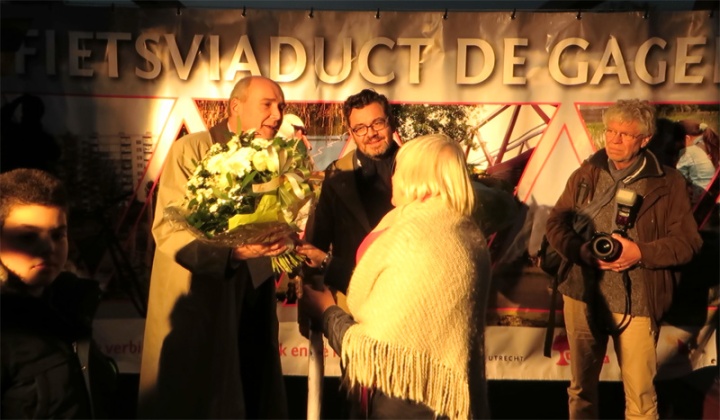
So is everything good about this bridge? Not entirely. Locals say the stair case (short cut) for pedestrians is very steep and the hand rail is too large to firmly hold it. The bridge may also be higher than necessary with steep ramps. But my mother was able to push my father up there in his wheel chair. (This bridge is very close to their home and they strolled there to have a look). So I think it may be quite all-right.
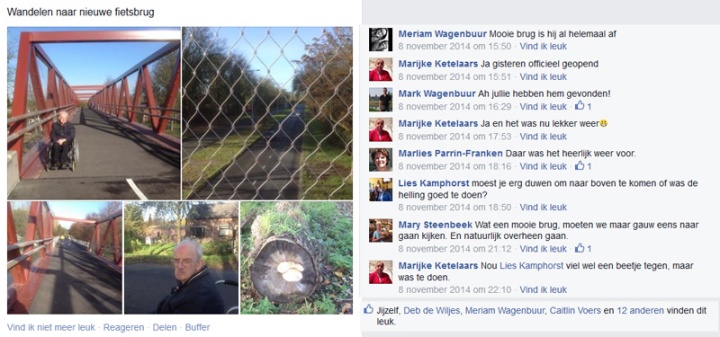
Relocating trees
A few weeks after the official opening there was another public gathering in which school children planted 28 new trees around the bridge. They were placed on the body of the entrance ramps and came partly in the place of 21 trees that had to be removed earlier, to make room for these very entrance ramps of the viaduct. These 30 year-old pin oaks with a height of 12 to 14 metres did fortunately not have to be cut down: they could be relocated. They have a trunk of about 40 centimetres and their root system was cut out of the ground in a lump of 4 cubic metres. That means an entire tree like that weighs about 15 to 20 metric tons. Of the 21 trees, 14 stayed in the area. They were replanted near their original location. But 7 trees were transported horizontally to a brand new park in the west of the city, the Queen Máximapark in a new neighbourhood, about 10 kilometres from their original location. Because it is nice to see mature trees in a new area.
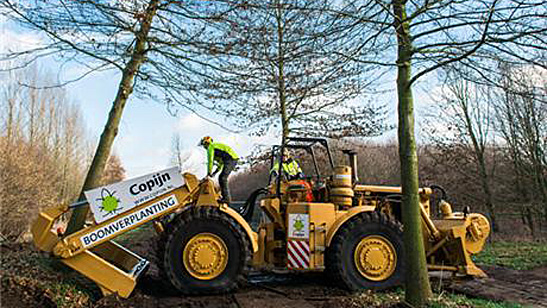
My second video shows a ride on the bridge filmed last December. So it already shows the newly planted trees. You will also see that the connecting cycling infrastructure at both sides of the bridge is purely recreational. Especially on the far side in the Noorderpark, it is of a width that is only suitable for recreational cycling. It would be far too narrow for everyday cycling. These cycleways are also not lit, and neither is the bridge. Quite different from the every day cycle way that is also crossed under the bridge. That is wide, lit and with red asphalt. Cycling from A to B has different requirements than cycling as a leisure activity, so there are different networks for these different activities in The Netherlands.
Video: riding the Cycle Viaduct “De Gagel” in Utrecht Overvecht.

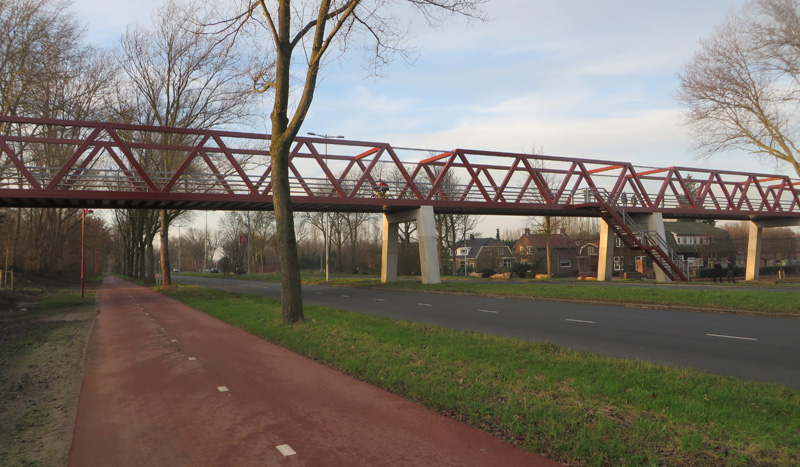
Hoi Marc! Thanks for showing us all this video, demonstrating yet again that authorities in NL are not afraid to directly tackle such a simple problem of crossing a ring road, by providing such a great piece of engineering for the benefit of padestrians and cyclists alike. I agree with Reid, yes it is great that this was constructed to such a high standard for the benefit of CYCLISTS, regardless of it’s construction cost. For this to be considered important enough to build at cost in the UK, would be very rare I think. However, I am left wondering if this bridge would have been built, if it had NOT been for access to the nature park (ie, if no park existed there), and only a residentual area to benefit?? Could the Tour De France coming to Utrecht also be an incentive in building this bridge THIS year I wonder? Either way, it’s great to see authorities cooperate with requests from the many users now enjoying the access this bridge provides.
I would love a chinese lantern by the way! Tot Zeins!
The whole point of the bridge is to connect the nature park to the residential area. Aside from the nature park, that area outside of the ring road is quite lowly populated agricultural land, so without there would not be much benefit of building a bridge.
As to the Tour de France: I’d doubt it has had any impact. Race cycling and normal everyday cycling are considered to be two completely different things, it would be like incentive to finish a small pedestrian bridge because you’re organizing a huge marathon.
Is there some glass or is it wire both sides enclosing the bridge?
I can find a 15km section of the Monash freeway here in Melbourne that cuts through the suburbs and only has 2 legal bicycle crossings which aren’t riding out in the general traffic at 60-80km/h. Its obvious to the cyclists here why more people don’t take up cycling, the lack of these continuously separated and relatively direct routes.
No glass, only wires on either side.
This bridge is about 5 minutes by bike from where I live too, I’ve been looking forward to it opening 🙂
Great post. The people put in charge of undertaking these projects in Utrecht seem quite keen to please the actual people in charge i.e. the people of Utrecht, particularly the end users of the infrastructure in question. I really liked the detail about the seven mature trees being re-planted in a new neighbourhood park, seemingly so the amenity gap between new and old is reduced at quickly as possible, which I surmise is done in order that everybody is able to reach the desired national state-of-mind of “gezellig”.
You are probably right. Neat and tidy, welcoming and warm, agreeable and pleasing, (all that would vaguely describe ‘gezellig’) is a state that the Dutch are seeking often… even unconsciously. If that leads to this… nice! 🙂
Excellent posting as usual! I’m amazed to see complex and expensive infrastructure like this dedicated to cycling and pedestrians. It’s great for everyone. It’s also good to see the opening ceremony which such excellent participation. The politicians deserve to get recognition for their efforts.
Coincidentally, a small (by comparison) addition to our infrastructure was just completed. I rode it for the first time on Saturday. Here is my posting on flickr – https://www.flickr.com/photos/reid2008/16117473127/. It provides good connectivity to our downtown Fayetteville square.
I rode it again today. I met and thanked some of the contractors who were responsible for creating the addition. There has been no opening ceremony. If the contractors are there when I do my ride tomorrow I will see what they think about a ceremony. They could suggest it to the local officials who hired them.
Keep up the great postings.